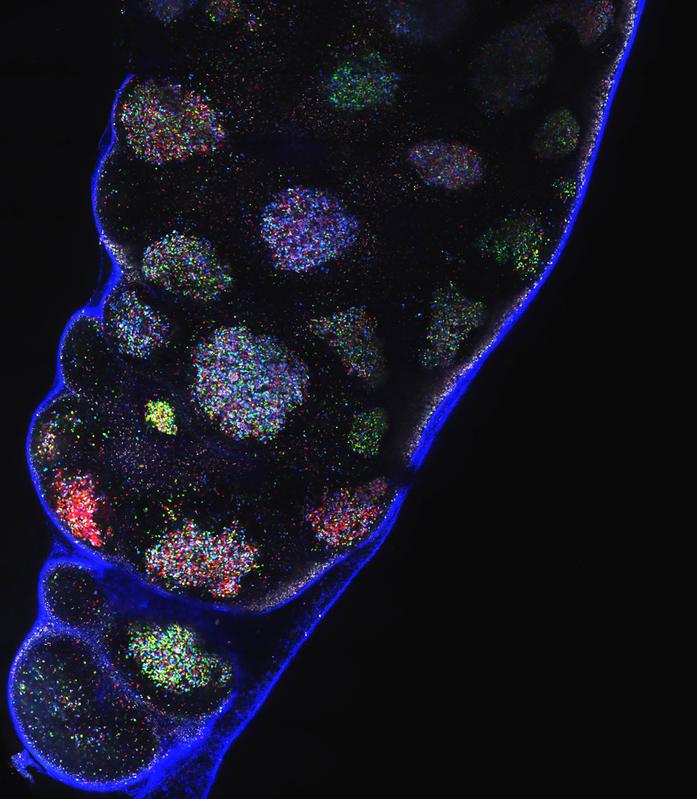Flexibility, rather than perfection, helps in the fight against pathogens

Mesenteric lymph node of a Confetti mouse infected with Friend retrovirus. The clusters of colored cells are germinal centers showing different levels of color dominance © Gabriel D. Victora
When a foreign substance invades a body, the body produces antibodies that recognise and fight the intruder by means of antibodies that bind to a specific portion of the intruder – the antigen. Memory cells are then formed in the course of the defence reaction.
These cells make sure that the body can respond more quickly and more strongly to any recurring attack of the same pathogen. According to a study just published in “Science” by scientists of the Whitehead Institute for Biomedical Research, Cambridge, USA, and the Helmholtz Centre for Infection Research (HZI) in Braunschweig, Germany, the common notion, i.e. that the body produces antibodies with a perfectly fitting key-lock design for a specific antigen exclusively, is not true.
Antibodies are produced by a certain type of white blood cells called B-cells or B-leukocytes which patrol our lymph nodes in search of pathogens every day. When a B-cell binds to an antigen by means of its receptor, the B-cell either produces a reasonably well-fitting antibody directly or it gets involved in the formation of a germinal centre. Germinal centres are antibody training sites:
The B-cells proliferate in them, diversify their antibodies through mutation and optimise them through selection. “In the course of time, the affinity of the antibodies for the antigens increases. Basically, only the most effective antibodies persist. This evolutionary process is called affinity maturation,” says Michael Meyer-Hermann, who is the director of the “System Immunology” department at the HZI.
Meyer-Hermann and his colleague, Gabriel Victora, from the Whitehead Institute for Biomedical Research aimed to test this theory in the scope of a project funded by the Human Frontiers Science Program in order to find out more about the process of affinity maturation. For this purpose, the researchers combined single-cell sequencing with brainbow experiments, a technique that is common in brain and developmental research. In this technique, mother cells are stained with random fluorescent proteins, which they then pass on to their daughter cells.
“This allows us to recognise exactly which lineage the cells have come from, and which founder cells dominate the germinal centre,” says Meyer-Hermann. “According to what was known, we presumed that only a few cells established the germinal centre and that the strong selection pressure would lead to uni-coloured germinal centres.”
The results of the sequencing were astounding: “According to common belief, there are on the order of three to five founder cells per germinal centre. We just showed that the number is closer to 100,” says Meyer-Hermann. The brainbow experiments showed that the germinal centres do not become as uni-coloured as expected. While some centres turned uni-coloured in the course of the antibody selection process, there were others which consisted of different colours even after a long period of time.
This means that there is not one definite dominant antibody, but that many different antibodies coexist.
Perhaps it is not always of advantage to adapt perfectly to a pathogen. After all, the pathogens keep developing too. “The more specific the antibodies are, the more difficult it may be for them to respond to mutations in the pathogens,” says Meyer-Hermann. “Accordingly, a certain degree of variability and flexibility could be crucial for keeping up with the constantly changing pathogens.”
In the long term, these insights might help in the development of new vaccines, since antibodies are the fundamental basis of vaccines. “Once we know what affects the ratio of dominant-clone versus diverse germinal centres, we can specifically adapt the diversity of the induced antibodies to the mutation rate of the pathogen in the vaccination protocols we use,” says Meyer-Hermann.
http://www.helmholtz-hzi.de/en/news_events/news/view/article/complete/flexibilit… – Press release
Media Contact
All latest news from the category: Life Sciences and Chemistry
Articles and reports from the Life Sciences and chemistry area deal with applied and basic research into modern biology, chemistry and human medicine.
Valuable information can be found on a range of life sciences fields including bacteriology, biochemistry, bionics, bioinformatics, biophysics, biotechnology, genetics, geobotany, human biology, marine biology, microbiology, molecular biology, cellular biology, zoology, bioinorganic chemistry, microchemistry and environmental chemistry.
Newest articles

NASA: Mystery of life’s handedness deepens
The mystery of why life uses molecules with specific orientations has deepened with a NASA-funded discovery that RNA — a key molecule thought to have potentially held the instructions for…

What are the effects of historic lithium mining on water quality?
Study reveals low levels of common contaminants but high levels of other elements in waters associated with an abandoned lithium mine. Lithium ore and mining waste from a historic lithium…

Quantum-inspired design boosts efficiency of heat-to-electricity conversion
Rice engineers take unconventional route to improving thermophotovoltaic systems. Researchers at Rice University have found a new way to improve a key element of thermophotovoltaic (TPV) systems, which convert heat…



